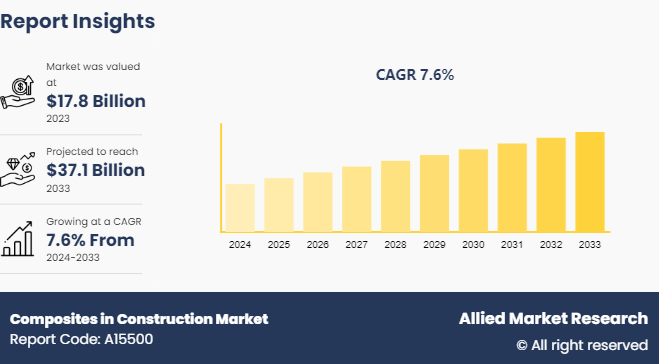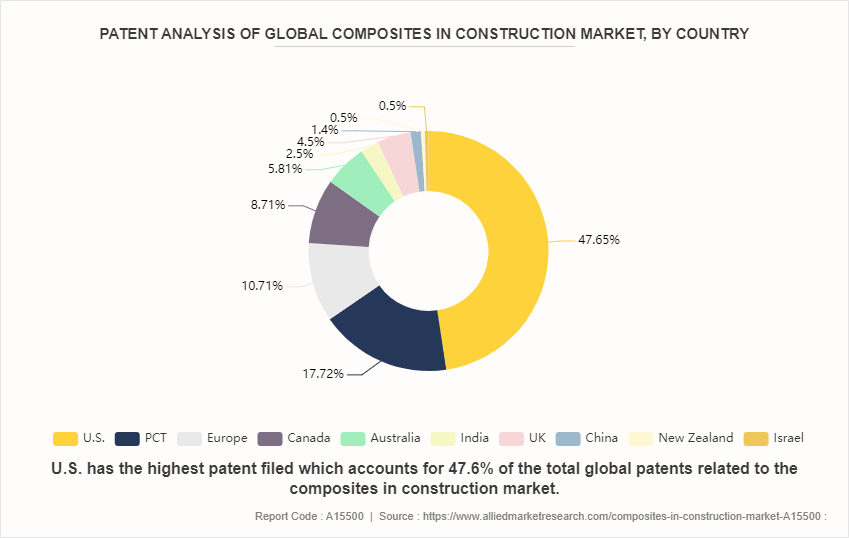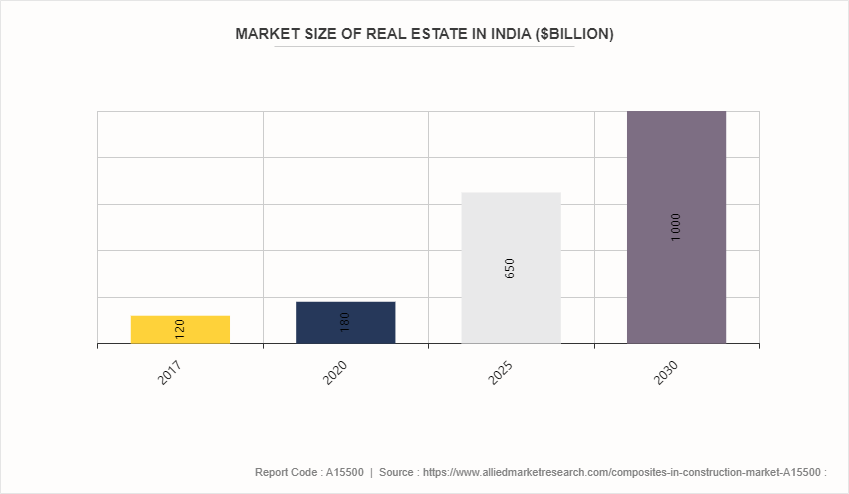Composites In Construction Market Research, 2033
The global composites in construction market was valued at $17.8 billion in 2023, and is projected to reach $37.1 billion by 2033, growing at a CAGR of 7.6% from 2024 to 2033.

Market Introduction and Definition
Composites in construction refer to materials that are made by combining two or more constituent materials with different physical or chemical properties. When these materials are combined, they produce a material with characteristics different from the individual components. The primary constituents in composites are the matrix (binder) and the reinforcement. The matrix material surrounds and binds together fragments of the reinforcement, creating a material with enhanced structural and mechanical properties. In addition, composites are highly resistant to environmental factors such as corrosion, weathering, and chemical exposure. This durability translates to longer lifespans and lower maintenance costs compared to traditional construction materials like steel and concrete. Furthermore, composites can be engineered to meet specific performance requirements, allowing for greater design flexibility and innovation in construction projects.
Key Takeaways
The composites in construction market study covers 20 countries. The research includes a segment analysis of each country in terms of value ($Billion) for the projected period 2023-2033.
India is the leading real estate investment market in Asia. Construction margins in India are also double that of the world average a perfect combination that makes India the most profitable construction market in the world.
More than 2, 500 product literatures, industry releases, annual reports, and other such documents of major composites in construction industry participants along with authentic industry journals, trade associations' releases, and government websites have been reviewed for generating high-value industry insights.
The study integrated high-quality data, professional opinions and analysis, and critical independent perspectives. The research approach is intended to provide a balanced view of global markets and to assist stakeholders in making educated decisions to achieve their most ambitious growth objectives.
Key Market Dynamics
Lightweight construction using composites enables the construction of taller buildings instead of compromising on safety or structural integrity. This capability is particularly advantageous in urban areas where space is limited, and there is a growing trend towards vertical expansion. By using composites, builders achieve higher strength-to-weight ratios, allowing for more efficient and sustainable construction practices. In addition, the demand for lightweight materials in construction aligns with broader environmental goals, such as reducing carbon footprints and energy consumption during construction and throughout the lifecycle of buildings. Composites, often made from recyclable materials and requiring less energy to produce, contribute to sustainability efforts in the construction industry. All these factors are expected to drive the growth of composites in construction market.
However, construction materials such as concrete and steel, and composites often involve higher upfront expenses. These costs stem from several factors, including the specialized manufacturing processes required for composites, which are more complex and technologically intensive compared to conventional materials. In addition, the cost of raw materials for composites, such as carbon fibers or high-performance resins, tends to be higher than traditional construction materials. While advancements in manufacturing technologies and material sourcing have gradually lowered these costs over time, composites still generally command a premium price compared to widely available alternatives. All these factors are expected to hamper the growth of the composites in construction market.
In the construction industry, composite materials' improved lifetime and durability provide significant prospects. Conventional building materials such as steel, concrete, and wood frequently face problems with weathering, biological deterioration, and corrosion over time. In contrast, composites offer superior resistance to these issues, that makes them an attractive alternative for long-lasting and low-maintenance construction solutions. Structures made from composite materials withstand repeated loading and environmental stress without significant deterioration. This durability is crucial for applications such as bridges, high-rise buildings, and transportation infrastructure, where materials are subjected to constant mechanical stresses. The ability of composites to maintain their structural integrity over time ensures both safety and reliability. All these factors are anticipated to offer new growth opportunities for the composites in construction market during the forecast period.
Patent Analysis of Global Composites in Construction Market, By Country

The U.S. collectively holds around half of the total composites in construction patents that indicate strong innovation and investment in this technology in the U.S. countries. This suggests fierce competition and a significant focus composite in construction market R&D in these leading economies. U.S. has the highest patents filed which accounts for 47.6% of the total global patents related to the composites in construction market. Europe and PCT, although holding smaller percentages of composites in construction patents individually, collectively contribute to the overall Asian dominance in composites in construction innovation. The recent surge in patent filings related to composites in construction highlights the significant strides made in materials science and engineering research and development within the industry.
Market Segmentation
The composites in the construction market is segmented on the basis of fiber type, resin type, end-use industry, and region. By fiber type, the market is classified into carbon fiber, glass fiber, natural fiber, polymer fiber, and others. By resin type, the market is segmented into epoxy, polyurethane, polypropylene, polyester, and others. Region-wise, the market is studied across areas such as North America, Europe, Asia-Pacific, and LAMEA.
Regional Market Outlook
As North America experiences significant urbanization and population growth, there is a pressing need for expanding and upgrading infrastructure. Cities are growing and new urban areas are being developed, necessitating the construction of more buildings, bridges, and transportation networks. Composites are increasingly preferred in these projects due to their superior strength-to-weight ratio, durability, and resistance to environmental factors, which make them ideal for the demands of modern urban infrastructure. North America existing infrastructure is aging and in need of repair or replacement. Traditional construction materials such as steel and concrete, while strong, often suffer from issues such as corrosion and weathering, leading to high maintenance costs and potential safety hazards over time. Composite materials offer a compelling alternative, providing enhanced durability and lower maintenance requirements. In Canada, as part of the "Investing in Canada" plan, the government announced plans to invest nearly $140 billion in major infrastructure developments in the country by 2028. As a result, the composites in construction market is expected to see robust growth, driven by the heightened need for advanced materials in large-scale infrastructure projects.
Competitive Landscape
The major players operating in the composites in construction market include Toray Industries Inc., Hexcel Corporation, Owens Corning, Sika AG, BASF SE, Huntsman Corporation, Nippon Electric Glass Co. Ltd., PPG Industries, Inc., TEIJIN AUTOMOTIVE TECHNOLOGIES, Teijin Limited and others.
Market Size of Real Estate in India

The construction industry's composites are expected to be greatly impacted by the significant rise in India's real estate market, which is expected to reach $650 billion by 2025 and $1, 000 billion by 2030, from $120 billion in 2017. Rise in real estate values usually translate into higher demand for innovative, long-lasting, and reasonably priced building materials such as composites. These materials are appealing for contemporary building projects that aim for sustainability and efficiency owing to their strength-to-weight ratio, resistance to corrosion, and design flexibility.
Industry Trends
China plans to expand its railway network, which is the second largest in the world, by one-third in the next 15 years, as part of a long-term plan to propel urbanization and stimulate local economies. According to a plan issued by the state-owned China State Railway Group, China aims to have about 200, 000 km (124, 274 miles) of railway tracks by the end of 2035, including about 70, 000 km of high-speed railways, which is expected to drive substantial demand for high-performance construction materials.
According to India Brand equity foundation, investment of $750 billion towards railway infrastructure by 2030 and India's ambitious objective of investing $1.4 trillion between 2019 and 2023 are expected to greatly enhance the composites market in the construction industry.
Construction is the third-largest sector in terms of FDI inflow. FDI in the sector (including construction development & activities) stood at $58.5 billion from April 2000 to September 2023. This substantial FDI influx reflects the sector's rapid growth and modernization, driving the demand for advanced construction materials such as composites.
Key Sources Referred
World Economic Forum
MDPI
American Society of Civil Engineers.
Invest India
International Renewable Energy Agency
India Brand Equity Foundation
International Energy Agency
IABG
Key Benefits For Stakeholders
This report provides a quantitative analysis of the market segments, current trends, estimations, and dynamics of the composites in construction market analysis from 2024 to 2033 to identify the prevailing composites in construction market opportunities.
The market research is offered along with information related to key drivers, restraints, and opportunities.
Porter's five forces analysis highlights the potency of buyers and suppliers to enable stakeholders make profit-oriented business decisions and strengthen their supplier-buyer network.
In-depth analysis of the composites in construction market segmentation assists to determine the prevailing market opportunities.
Major countries in each region are mapped according to their revenue contribution to the global market.
Market player positioning facilitates benchmarking and provides a clear understanding of the present position of the market players.
The report includes the analysis of the regional as well as global composites in construction market trends, key players, market segments, application areas, and market growth strategies.
Composites in Construction Market Report Highlights
| Aspects | Details |
| Market Size By 2033 | USD 37.1 Billion |
| Growth Rate | CAGR of 7.6% |
| Forecast period | 2024 - 2033 |
| Report Pages | 340 |
| By Fiber Type |
|
| By Resin Type |
|
| By Region |
|
| Key Market Players | PPG Industries, Inc., Sika AG, Teijin Limited, Nippon Electric Glass Co. Ltd., Huntsman Corporation, Hexcel Corporation, Owens Corning, TEIJIN AUTOMOTIVE TECHNOLOGIES, BASF SE, Toray Industries Inc. |
Increasing use of sustainable and recyclable composites. growth in prefabricated composite building components are the upcoming trends of Composites in Construction Market in the world.
North America is the largest regional market for Composites in Construction
$37.1 billion is the estimated industry size of Composites in Construction by 2033.
Rising demand for sustainable construction solutions are the key factors boosting the composites in construction market growth.
Toray Industries Inc., Hexcel Corporation, Owens Corning, Sika AG, BASF SE, Huntsman Corporation, Nippon Electric Glass Co. Ltd., PPG Industries, Inc., TEIJIN AUTOMOTIVE TECHNOLOGIES, Teijin Limited are the top companies to hold the market share in Composites in Construction
Loading Table Of Content...


